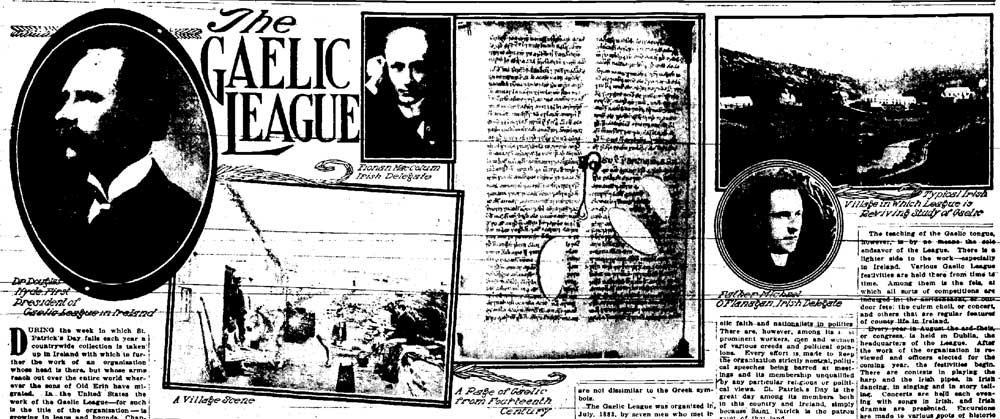Fr Flanagan and Irish Lace 1908
Father Michael Flanagan at Head of Crusade to Break Shackles From His Native Land
Let it not be thought for an instant that the coming of the Irish lace makers to San Francisco, over the sea and over the continent, is a mere commercial enterprise. Women throng Hale's Market street store to see the dainty handicraft of the Loughlynn school and to watch the three smiling Irish girls work their witcheries of thread and needle, for it is a show worth anybody's seeing; but it needs the story that Father Michael Flanagan tells to make plain the actual and high purpose of this far pilgrimage.
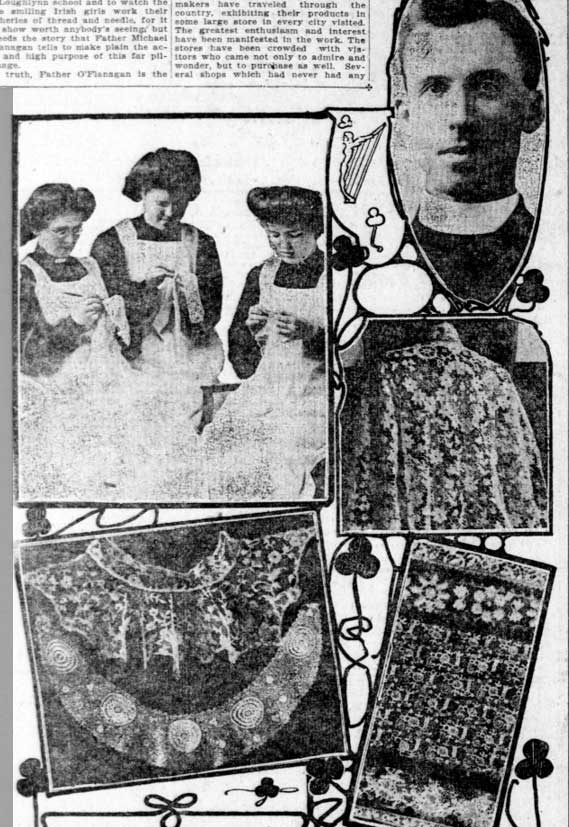
In truth, Father Flanagan is the Industrial missionary of Ireland-to-be, preaching a gospel which will make that "most distressful country" once more a free nation. His is a mission of intense patriotism, of the sentiment that thrills every liberty loving heart. The road he walks with his little band of lace makers, through stores and fairs and expositions, from city to city and land to land, seems long and roundabout, but he knows, and those who sent him know where he is going.
Rosy Cheeked Maids Make Lace to Aid in Freeing Ireland Through Industry
It is worth while to see the colleens at Hale's making lace and to finger the fine and fllmy products of their art, but it is much more worth while to hear Father Flanagan prove how the revival of Irish industry is to set Ireland free. A young priest he is, soft and low of voice, clear cut of features as he is clear cut of thought; a zealous priest, his deep eyes glowing with patriotic fervor. He is entertaining when he explains the fairy patterns, the webs of shimmering gossamer; he is eloquent when he tells how and why the devoted patriots for whom he speaks are reviving this and other Irish industries. He is frank to explain that the lace makers and the laces of this exhibit are but his means to an end - and that end is to get him a hearing wherever he goes on behalf of Ireland and the industrial revival that is to make Ireland first commercially and then governmentally independent; it is a simple plan, but all across this continent it has proved wondrously effective.
GRADUATES OF SCHOOL
The three girl lace makers are Mary Flanagan, Rose Egan and Mary Kate Davoren, all graduates of the industrial school established by Right Rev. Bishop John J. Clancy at Loughlynn, County Roscommon, Ireland.
The lace industry in Ireland is 60 years old, but in common with other Irish industries, it has languished under the political conditions from which Ireland has suffered so long. It is Father Flanagan's belief that more good will come to Ireland, and that quicker relief from her unhappy situation will come from the support and revival of her many old time industries than from an appeal for aid in other directions. To this end he has been sent by Bishop Clancy to rnake a lecture tour of America that the Industrial situation in Ireland may be placed before Americans and his compatriots in America, and an effort made to awaken interest in one of the most charming and exquisite industries that Ireland or the world has ever known.
In pursuance of this, idea Father Flanagan and these three Irish lace makers have traveled through the country, exhibiting their products in some large store in every city visited. The greatest enthusiasm and interest have been manifested in the work. The stores have been crowded with visitors who came not only to admire and wonder, but to purchase as well. Several shops which had never had any call for Irish laces before have sold as much as $100 worth a day. It is expected hat every lace making school in Ireland will feel the impetus of this aroused interest and increased trade and that this stimulus will spread to the other Irish manufactures which have for so long been practically dead.
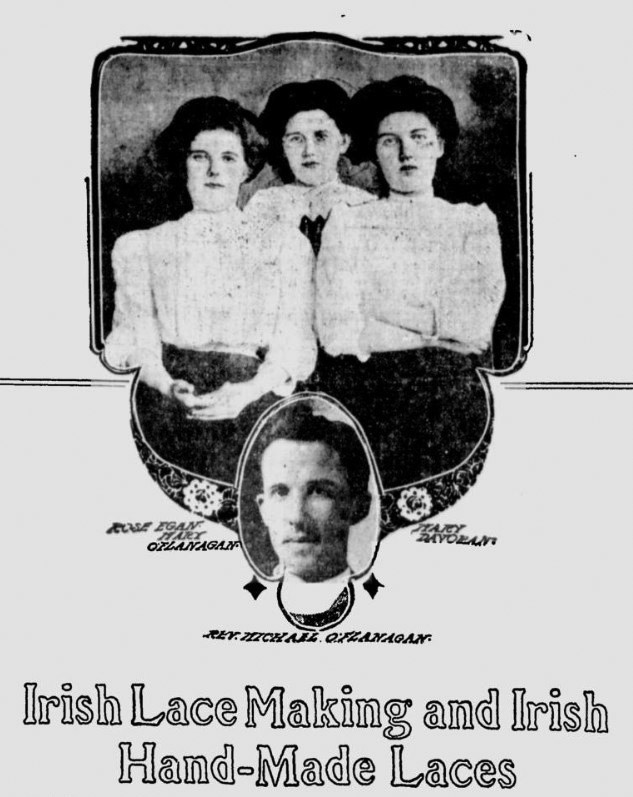
MAKE WONDROUS WARES
These marvelous laces - the "Carrickcmacross," the "baby Irish, the "Limerick" and "Irish point" - are made in Ireland by young girls, convent taught, who work at the industry in their spare moments, unless specially destined for the trade. Lace making is taxing on the eyes and for this reason cannot be carried on steadily too long at a time. The "Irish point" is built entirely with a plain sewing needle. There are two kinds, flat and raised, the first being made solely of thread with no supporting background, the second showing a foundation of three or four threads.
The "Carrickmacross" is appliqued on muslin, a pattern being drawn on paper, which is then overlald with fine net, which in its turn is overlaid with muslin thin enough to permit the pattern to show through. Roses, shamrocks or lilies are then outlined on the muslin with a fine thread and afterwards cut out, leaving only the net in places where the design is not drawn. This lace was designed as an improvement on the "Limerick," in which the central portions of the flowers and leaves are darned in with inflnite skill and care, though at a great loss of time as compared with the other method.
GET BETTER PRICES HERE
Of course the prices for work of thls kind are far higher in America than in Ireland. As native lace maker said that she had seen a small lace medallion made in Ireland for 2 cents, while it - retailed in America for 85 cents. There is a similar story of another Irish girl who was taken to one of the principal stores at the east where she saw several lace designs exactly like those she had made herself at home. When told the price asked for them her amazement was deep — lt was exactly 52 times the price asked in Ireland. It does not cost much to buy a needle and a spool of thread, but they enable the bright Irish girl to produce an artlcle that can not be duplicated anywhere in the world.
As an example of tbe prices obtained in this country for these famous laces it may be stated that a small straight collar and narrow cuffs of the Irish point bring $65, while a jacket made of heavy Irish crochet is valued at $45. It takes long to produce one of these pieces of intricate and difficult handiwork and when it is considered that every stitch is placed by hand and that the slightest unevenness or discrepancy in the number of stitches will spoil the effect the price asked for this work, even if done by young glrls some of whom can pick up the knack of it in a few months, is not to be wondered at.
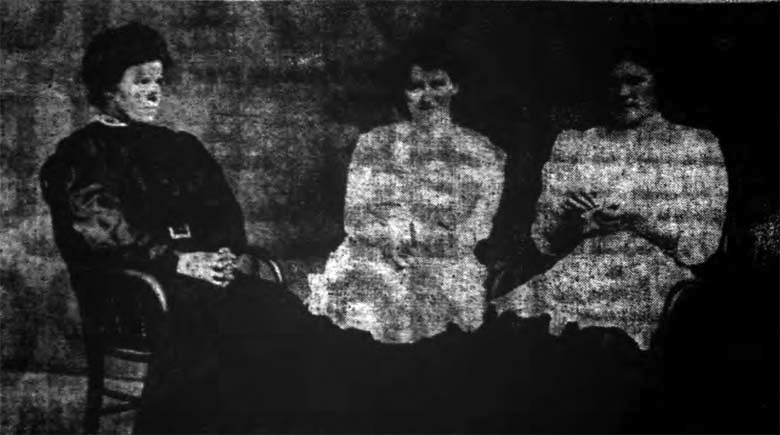
IRELAND'S INDUSTRIES CRUSHED
In connection with the lace making industry and the way in which it, in common with other industrial enterprlses have been crushed, the views of Lord Dufferin, a man who occupied at one time one of the very highest positions in the gift of the English crown, are significant, in the light of their possible revival. Lord Dufferin says:
"From Queen Elizabeth's time until within a few years ago all the known and authorized commercial fraternities of Great Britain never for a moment relaxed their relentless grip on the trades of Ireland. One by one each of our nascent industries was either strangled at its birth or handed over gagged and bound to the jealous custody of the rival Industry in England, until at last every fountain of wealth was hermetically sealed and even the traditions of commercial enterprise perished through desuetude.As early as the commencement of the sixteenth century the beeves of Roscommon, Tipperary and, Queens county undersold the produce of the English grass counties in their own market. Our cattle trade was abolished and we tried sheep farming. The English sheep breeders took alarm and Irish wool was declared contraband by a parliament of Charles ll. Headed off in this dlrection we tried to work up the raw materlal at home, but this created the greatest outcry of all. Every maker of fustian flannel and broadcloth in. England rose up in arms and, by an act of William III, the woolen iindustry of llreland was extinguished and 20,000 manufacturers left the island.
Our woolen industry crushed we next made a dash at the silk business, but the silk manufacturer proved as pitiless as the wool stapler. The cotton manufacturer, the sugar refiner, the soap and candle maker and every other trader that thought it worth while to petition were received by parliament wlth the same cordiality until the most searching security failed to detect a single vent through which it was possible for the hated Industry of Ireland to respire."
Now the dawn is breaking. Father Flanagan declares that many promlnent men are interested in this hoped for revival of Irish activities, and that a break has been made in the wall of prejudice and misunderstanding. The lace making industry is among the first to be re-established in a small way; but even now the demand is greater, than then supply. These three young Irlsh girls are, it may be, the forerunners which tell of Ireland's reblrth. Success is smiling at them in this far land, and Father Flanagan has flrm faith that in thls and no other way will Ireland's former Independence be restored.
San Francisco Call, 31 May 1908
Rev Fr Flanagan Addresses Oakland Clubwomen on His Mission
TELLS OF CRUSADE TO AID INDUSTRIES
OAKLAND, June. 10th.— Rev. Father Michael Flanagan of Ireland, who is touring America with three young women, expert lace makers, to awaken interest in an industrial revival in his native land, which he hopes will make the 'Emerald isle' commercially and politically independent, was the guest of honor at a meeting of the Oakland club this afternoon in Pythian castle. In a brief talk that was permeated with patriotism, sentiment and sound sense the priest explained the object of his mission to a large assemblage of clubwomen and the means by which it is planned to bring about the end desired.
TELLS OF LACE MAKING
Father Flanigan entertained and instructed hls auditors with a detailed description of how the marvelous laces of fairy pattern are made. He asserted that the lace industry in lreland, in common with other industries, had languished under the strangling legislation enacted by the British government to protect rival industries in England. He declared that but two per cent of the value of the laces is paid as wages to the girls who crochet the exquisite fabrics and placed the blame for the meager pay allowed the expert workers upon the Hibernian lace company, a concern which, the speaker said, had branches throughout Ireland and which is operated by English capital.
AIDS INDUSTRIAL REVIVAL
Father Flanagan stated that the trip he and his trio of lace workers are making in this country was only a means to, an end. That end is to give him an opportunlty of speaking on behalf of the Industrial revival In Ireland, which the priest said meant much to the future of the Emerald isle. According to Father O"Flanagan Irish laces bring from ten to fifty times more in the United States than they do in Ireland.
It is the belief of the priest that more good will come to Ireland through the revival of many of her old time industries than from any other source. The making of lace is one of the first of the practically obsolete industries of Ireland to be revived and Father Flanagan is highly gratified at the success that the movement has met with thus far. He says that even now the demand created in this country for the artistic handiwork of the Irish lace makers greatly exceeds the supply.
San Francisco Call, 11 June 1908.
Rev. Father Flanagan, Who Has Party of Lace Makers in Sacramento, has a unique plan to do advertising
Experts in Manufacture of Irish Product Now at Big White Store.
He first came to the United States about two years ago and has lectured throughout the country. He says that the oppressions of Ireland by England have been similar to those imposed upon the American colonists which resulted in the Declaration of Independence and war of the revolution.
England sells annually $200,000,000 worth of manufactured articles in Ireland. The British government imposed restrictions on Irish factories that were prohlbitory. For many years and up until the middle of the last century Industrial organization was forbidden in Ireland. All the distant colonies, like America, won their freedom so far as manufacturing was concerned, but the English grip on Ireland was not loosened. They would not permit an Irish factory to compete with an English industry.
Father O'Flanagan represents directly the technical schools of Loughlynn and Roscommon counties, which are under the patronage of Bishop Clancy. The bishop visited America last November and is coming again in July. The course England has pursued toward Ireland has driven the Industrial spirit out of the people, and Father O'Flanagan and the people he represents are trying to revive it, to make Ireland a manufacturing country and put a stop to emigration. His desire is to awaken a loyalty in this country to Ireland, so strong that the people wull not only wear a green tie and sport a shamrock, but that they will don a suit of Irish-made clothing as well.
The result of this movement has already revived a spirit of Industry. New factories are going up, old ones enlarged, and people have almost ceased to leave that country in order to better their condition. It is the only country in Europe, the only country in the civilized world, that is losing in population. Sixty years ago the census noted 8,000,000 people, and today it has but 4,250,000. Even Poland under Russian rule has more than doubled in that time. Ireland is larger than Belgium and Holland combined, yet those two countrie.s support three times as great a population.
In order to get the best result out of his tour of the United States, he gives some interesting object lessons, and for that purpose selected lace-making. He brought with him from the 'old country' three young women expert in that line of manufacture. They have given exhibitions in many of the large cities In various parts of the country and are now giving dally demonstrations at the store of the Weinstock-Lubin company in this city. This lace-making has been the means of advertising Irish industries, and serves to advertise Father O'Flanagan's lectures before local clubs.
Sacramento Union, 16 June 1908.
COLLEENS TO MAKE REAL IRISH LACE
Young Women From Emerald Isle Will Demonstrate Beautiful Art
Irish lace in all its beauty will be made in San Francisco during the next two weeks by young women experts who are graduates of one of the finest schools in the Emerald isle, and the proceeds of their work and ingenuity will be devoted to the cause of rehabilitating the industry of lace making. All of the young women are well known in the principal cities of the United States as it is their third tour under tbe direction of Rev. Father Michael Flanagan. and with the approval of Rt. Rev. John J. Clancy, bishop of Elphin diocese, Ireland.
The party, consisting of Misses Rose Egan. Mary Kate Donovan, Mary Flanagan and the priest, arrived in the city last night. The young ladies are at the Innisfail and Father Flanagan will be the guest of Rev. Father McQuaid at the rectory of the Sacred Heart while in the city. During the next two weeks Fr Flanagan will give several free lectures on the lace industry, as well as the ancient and modern arts of Ireland. The young women, garbed in the dress of the ancient lace makers, will lecture daily at Hale Bros., as well as demonstrating the art of making lace. The success which has attended the tours of America by the lace makers is shown by the fact that since 1907 they have liquidated a debt of $15.000 which stood against the school at Loughlynn, their alma mater.
San Francisco Call, 3 May 1909
Rosy Cheeked Maids Make Lace to Aid in Freeing Ireland Through Industry
Father Michael Flanagan at Head of Crusade to Break Shackles From His Native Land
COLLEENS TO MAKE REAL IRISH LACE
Young Women From Emerald Isle Will Demonstrate Beautiful Art
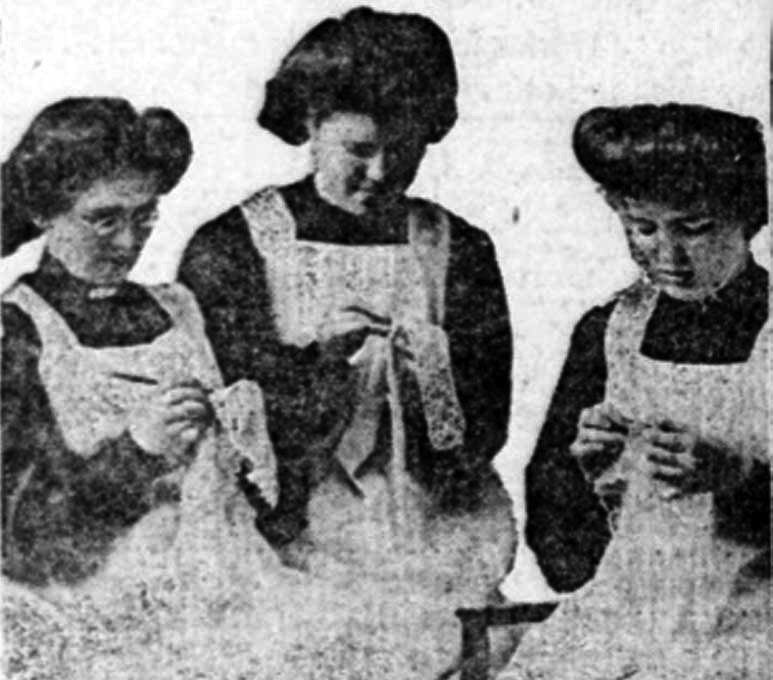
And good coverage for his plans for Ireland:
'It is worth while to see the colleens at Hale's making lace and to finger the fine and filmy products of their art, but it is much more worth while to hear Father Flanagan prove how the revival of Irish industry is to set Ireland free. A young priest he is, soft and low of voice, clear cut of features as he is clear cut of thought; a zealous priest, his deep eyes glowing with patriotic fervor. He is entertaining when he explains the fairy patterns, the webs of shimmering gossamer; he is eloquent when he tells how and why the devoted patriots for whom he speaks are reviving this and other Irish industries. He is frank to explain that the lace makers and the laces of this exhibit are but his means to an end - and that end is to get him a hearing wherever he goes on behalf of Ireland and the industrial revival that is to make Ireland first commercially and then governmentally independent; it is a simple plan, but all across this continent it has proved wondrously effective. '
Fr Michael joined the Gaelic League within days of his return from the United States in 1910. He was soon sent back to the US in August as part of a delegation to raise funds for the Irish language fund. Fr Flanagan organized another successful traveling exhibition of handmade Irish goods, where Misses Bridget Quinn, Eileen Noone and Bridie McGloughlin visited various cities demonstrating cottage industries such as lace making.
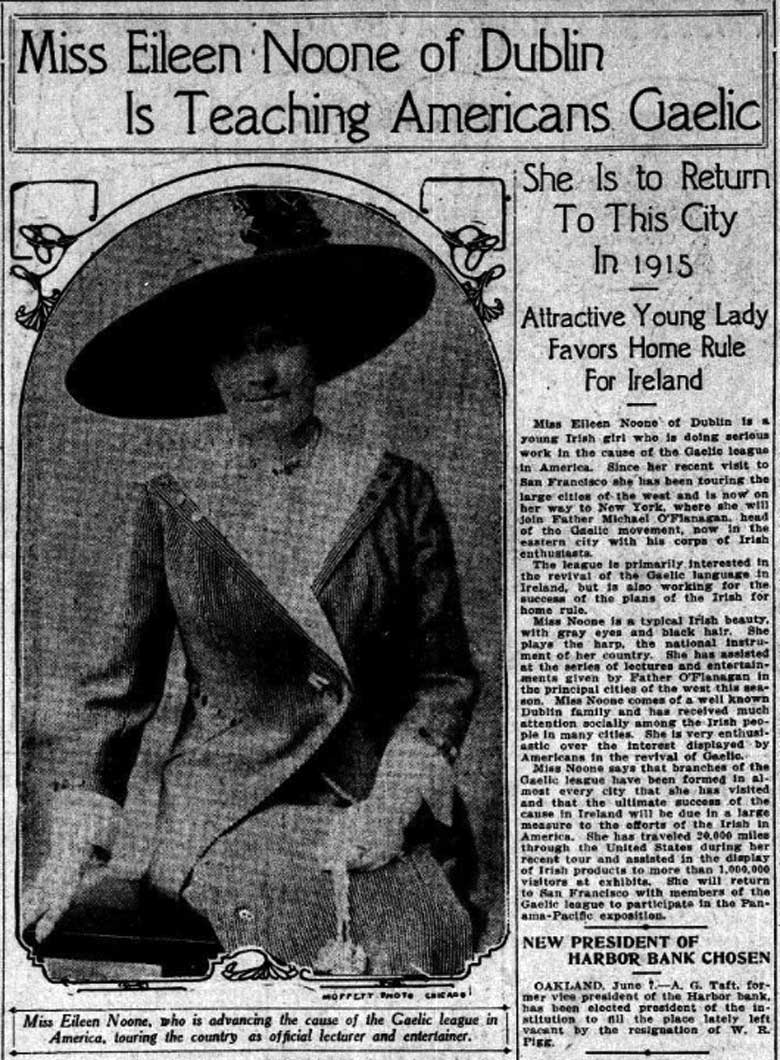
Miss Eileen Noone of Dublin Is a young Irish girl who is doing serious work in the cause of the Gaelic league in America. Since her recent visit to San Francisco she has been touring the large cities of the west and is now on her way to New York, where she will join Father Michael Flanagan, head of the Gaelic movement, now in the eastern city with his corps of Irish enthusiasts.
The league is primarily interested in the revival of the Gaelic language in Ireland, but is also working for the success of the plans of the Irish for home rule.
Miss Noone is a typical Irish beauty, with gray eyes and black hair. She plays the harp, the national instrument of her country. She has assisted at the series of lectures and entertainments given by Father Flanagan in the principal cities of the west this season. Miss Noone comes of a well known Dublin family and has received much attention socially among the Irish people in many cities. She is very enthusiastic over the interest displayed by Americans in the revival of Gaelic.
Miss Noone says that branches of the Gaelic league have been formed in almost every city that she has visited and that the ultimate success of the cause in Ireland will be due in a large measure to the efforts of the Irish in America. She has traveled 20,000 miles through the United States during her recent tour and assisted in the display of Irish products to more than 1,000,000 visitors at exhibits. She will return to San Francisco with members of the Gaelic league to participate in the Panama-Pacific exposition.
UNDER the auspices of the Growney branch of the Gaelic league a public welcome will be given to Father Flanagan, who is is San Francisco in the Interest of the lace making Industry, of Ireland. The reception will be free to all, and men and women of Irish birth and descent are expected to attend in large numbers to hear Father Flanagan's address on the "Irish Industrial movement." Father Flanagan is a fluent, eloquent and interesting talker and his message from the old land will be well worth hearing.The reception will be held at St. Peter's hall, Alabama and Twenty-fourth streets, next Tuesday evening, June 2 - A brief but select program of vocal and instrument selections will precede Father Flanagan's remarks as follows:
Michael Mahoney, principal of the Growney school, will introduce the chairman of the evening, who will be a man with rare knowledge of the Irish revival movement; chairman's address; Irish airs; the Growney musical society; Gaelic songs, children of St. Peter's school; selection of Irish airs on the violin by Professor Batt Scanlan; Gaelic song, Miss Loretto A. Barr; lecture on the national revival movement In Ireland, Rev. Father Flanagan; "Slainte n-Gaedheal, Miss Loretto A. Barr, assisted by the members of the Growney school.
The committee in charge of the reception consists of Joseph Kelly, Conor Murphy, James J. Caniffe, Frank S. Drady, Michael Mahoney, Thomas Connor, Daniel Connell, Daniel Harnedy and Miss Frances X Barr. The doors will open promptly at 7 o'clock. The program will begin at 8 o'clock.

